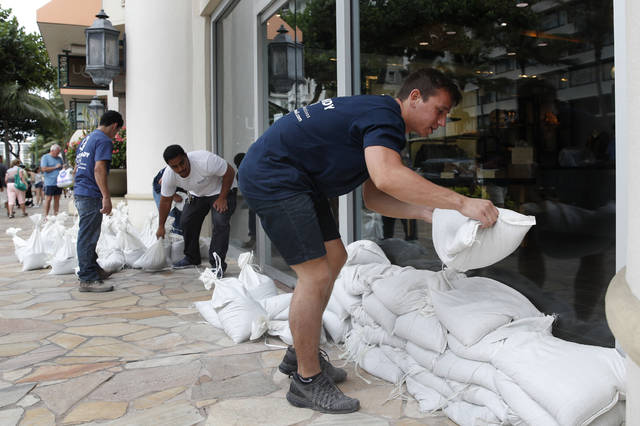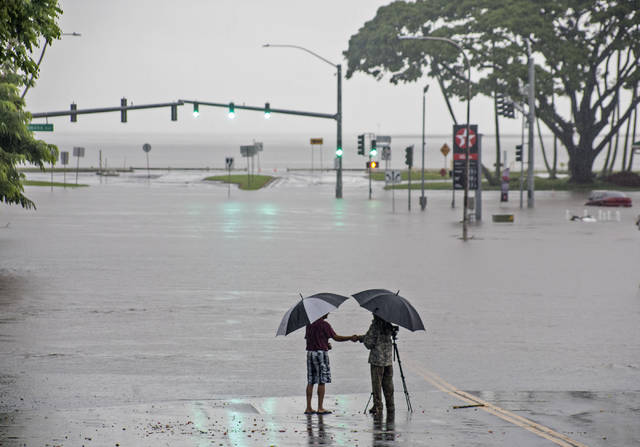HONOLULU — A powerful hurricane unleashed torrents of rain and landslides Thursday that blocked roads on the rural Big Island but didn’t scare tourists away from surfing and swimming at popular Honolulu beaches still preparing get pummeled by the erratic storm.
Employees of the Sheraton Waikiki resort on the famed beach filled up sandbags as shuttered stores stacked them against the bottom of their glass windows to prepare for heavy rain, flash flooding and damaging surf on Oahu, the most populated island.
Hurricane Lane already lashed the Big Island with nearly 20 inches of rain in nearly 24 hours and was moving closer to Hawaii, a shift that will put the Big Island and Maui “in the thick” of the storm, National Weather Service meteorologist Melissa Dye said. The agency says the storm has weakened to a Category 3 but can still cause major damage.
The hurricane with winds from 111 to 129 mph was expected to move close to or over portions of the main islands later Thursday or Friday, bringing dangerous surf of 20 feet (6 meters) and a storm surge of up to 4 feet (1 meter), forecasters said.
Lane was not projected to make a direct hit on the islands, but officials warned that even a lesser blow could do significant harm. Some areas could see up to 30 inches (about 80 centimeters) of rain.
“Rain has been nonstop for the last half hour or so, and winds are just starting to pick up,” said Pablo Akira Beimler, who lives on the coast in Honokaa on the Big Island. “Our usually quiet stream is raging right now.”
Beimler, who posted videos of trees being blown sideways, said staying put is about the only choice he has. The road to Hilo was cut off due to landslides, he said.
“We essentially have one way in and out of our towns so sheltering in place is the priority,” Beimler said in a Twitter message.
Roughly 200 miles (320 kilometers) away on Oahu, Elisabeth Brinson was still watching surfers from her balcony on the ninth floor of the Hawaiian Hilton Village in Waikiki, where she will ride out the storm.
“I don’t think we’re in too much trouble as far as flooding where we are now,” said the native of the United Kingdom now living in Denver.
Hotel staff left a notice that the rooms will still have water and phone service, and a backup generator will power one elevator per building.
Brinson said many shops were closed, and those still open were frantic with people buying food, beer and water to take back to their rooms.
“We knew it was coming, so I tried to just cram as much as I could into the last few days in anticipation so we could cross things off of our list,” said Brinson, who is accustomed to hurricanes after living in Florida. “You can’t really do much about the weather.”
Hawaii’s biggest hotels are confident they can keep their guests safe as long as they stay inside, said Mufi Hannemann, CEO of Hawaii Tourism and Lodging Association.
Members of his association, which include the state’s major hotels, are shifting into high gear with their emergency management plans, he said.
The Marriott Resort Waikiki Beach in Honolulu designated a ballroom on the third floor as a shelter for guests and began removing lounge chairs from around the pool and bar area.
“The only concern is those that venture outside of the properties, that would like to hike on a day like this or who would like to still go into the ocean and see what it’s like to take a swim or surf in these kind of waters,” Hannemann said.
Hotels are trying to warn travelers against that, he said.
Two campers were reported trapped overnight in Waipio Valley, along the Big Island’s northern coast. The campers called authorities Wednesday, but emergency crews could not mount a rescue operation.
“We can’t go in because the roads — there’s a river of water down there,” said Hawaii County Managing Director Wil Okabe.
Shelters are open throughout the islands, with 350 people in them in Oahu. Aid agencies were also working to help Hawaii’s sizable homeless population, many of whom live near beaches and streams that could flood.
Because there’s not enough shelter space statewide, Hawaii Emergency Management Agency Administrator Tom Travis urged people who were not in flood zones to stay home.
On the island of Lanai, it was eerily dead still and gray, said Nick Palumbo II, who owns Lanai Surf School and Safari.
“It’s relatively like a regular day,” he said by telephone. “I got friends calling me telling me there’s surf at the beach, and they’re actually going surfing right now.”
Palumbo is prepared for the storm after boarding up one large window and stocking up on snack food. He’s also got a freezer full of fish he’s caught on dives and deer he’s hunted to last his family through the storm.
“I don’t have a generator, but I figure as things thaw out, if the electricity goes, we’ll just get cooking,” he said.
As Hurricane Lane moved closer to the islands, it was expected to weaken more rapidly and turn toward the west.
The central Pacific gets fewer hurricanes than other regions, with about only four or five named storms a year. Hawaii rarely gets hit. The last major storm to hit was Iniki in 1992. Others have come close in recent years.
Because people in Hawaii are confined to the islands, they have to make sure they have enough supplies to outlast power outages and other potential emergencies.
The Federal Emergency Management Agency moved several barges packed with food, water, generators and other supplies into the region ahead of Hurricane Hector, which skirted past the islands more than a week ago, FEMA Administrator Brock Long said.
———
Associated Press writers Brian Skoloff in Honolulu Mark Thiessen and Dan Joling in Anchorage, Alaska, Seth Borenstein in Washington and Annika Wolters in Phoenix contributed to this report.




